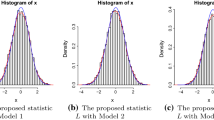Abstract
In this article we consider a pq-dimensional random vector x distributed normally with mean vector θ and covariance matrix Λ assumed to be positive definite. On the basis of N independent observations on the random vector x, we want to estimate parameters and test the hypothesis H: Λ = Ψ ⊗ Σ, where Ψ = (ψ ij ): q × q, ψ qq = 1, and Σ = (σ ij ): p × p, and Λ = (ψ ij Σ), the Kronecker product of Ψ and Σ. That is instead of 1/2pq(pq + 1) parameters, it has only 1/2p(p + 1) + 1/2q(q + 1) − 1 parameters. A test based on the likelihood ratio is given to check if this model holds. And, when this model holds, we test the hypothesis that Ψ is a matrix with intraclass correlation structure. The maximum likelihood estimators (MLE) are obtained under the hypothesis as well as under the alternatives. Using these estimators the likelihood ratio tests (LRT) are obtained. One of the main objects of the paper is to show that the likelihood equations provide unique estimators.
Similar content being viewed by others
References
P. Dutilleul, “The MLE Algorithm for the Matrix Normal Distribution”, J. Statist. Comput. Simulation 64, 105–123 (1999).
A. T. Galecki, “General Class of Covariance Structures for Two or More Repeated Factors in Longitudinal Data Analysis”, Comun. Statist. — Theory and Methods 23, 3105–3119 (1994).
T. Kollo and D. von Rosen, Advanced Multivariate Statistics with Matrices (Springer, Dordrecht, 2005).
N. Lu and D. L. Zimmerman, “The likelihood Ratio Test for a Separable Covariance Matrix”, Statist. Probab. Letters, 73, 449–457 (2005).
D. N. Naik and S. Rao, “Analysis of Multivariate Repeated Measures Data with a Kronecker Product Structured Covariance Matrix”, J. Appl. Statist. 28, 91–105 (2001).
R. F. Potthoff and S. N. Roy, “A Generalized Multivariate Analysis of Variance Model Useful Especially for Growth Curve Problems”, Biometrika 51, 313–326 (1964).
C. Ritz and I. M. Skovgaard, “Likelihood Ratio Tests in Curved Exponential Families with Nuisance Parameters Present only under the Alternative”, Biometrika 92, 507–517 (2005).
A. Roy and R. Khattree, “On Implementation of a Test for Kronecker Product Covariance Structure for Multivariate Repeated Measures Data”, Statist. Methodology 2, 297–306 (2005).
M. S. Srivastava, “Estimation of Intraclass Correlations in Familial Data”, Biometrika 71, 177–185 (1984).
M. S. Srivastava and C. G. Khatri, An Introduction to Multivariate Statistics (North Holland, New York, 1979).
D. F. Votaw, “Testing Compound Symmetry in a Normal Multivariate Distribution”, Ann. Math. Statist. 19, 447–473 (1948).
S. S. Wilks, “Sample Criteria for Testing Equality of Means, Equality of Variances, and Equality of Covariances in a Normal Multivariate Distribution”, Ann. Math. Statist. 17, 257–281 (1946).
Author information
Authors and Affiliations
Corresponding author
About this article
Cite this article
Srivastava, M.S., von Rosen, T. & von Rosen, D. Models with a Kronecker product covariance structure: Estimation and testing. Math. Meth. Stat. 17, 357–370 (2008). https://doi.org/10.3103/S1066530708040066
Received:
Published:
Issue Date:
DOI: https://doi.org/10.3103/S1066530708040066
Key words
- covariance structure
- flip-flop algorithm
- intraclass correlation structure
- Kronecker product structure
- likelihood ratio test
- maximum likelihood estimators
- repeated measurements




